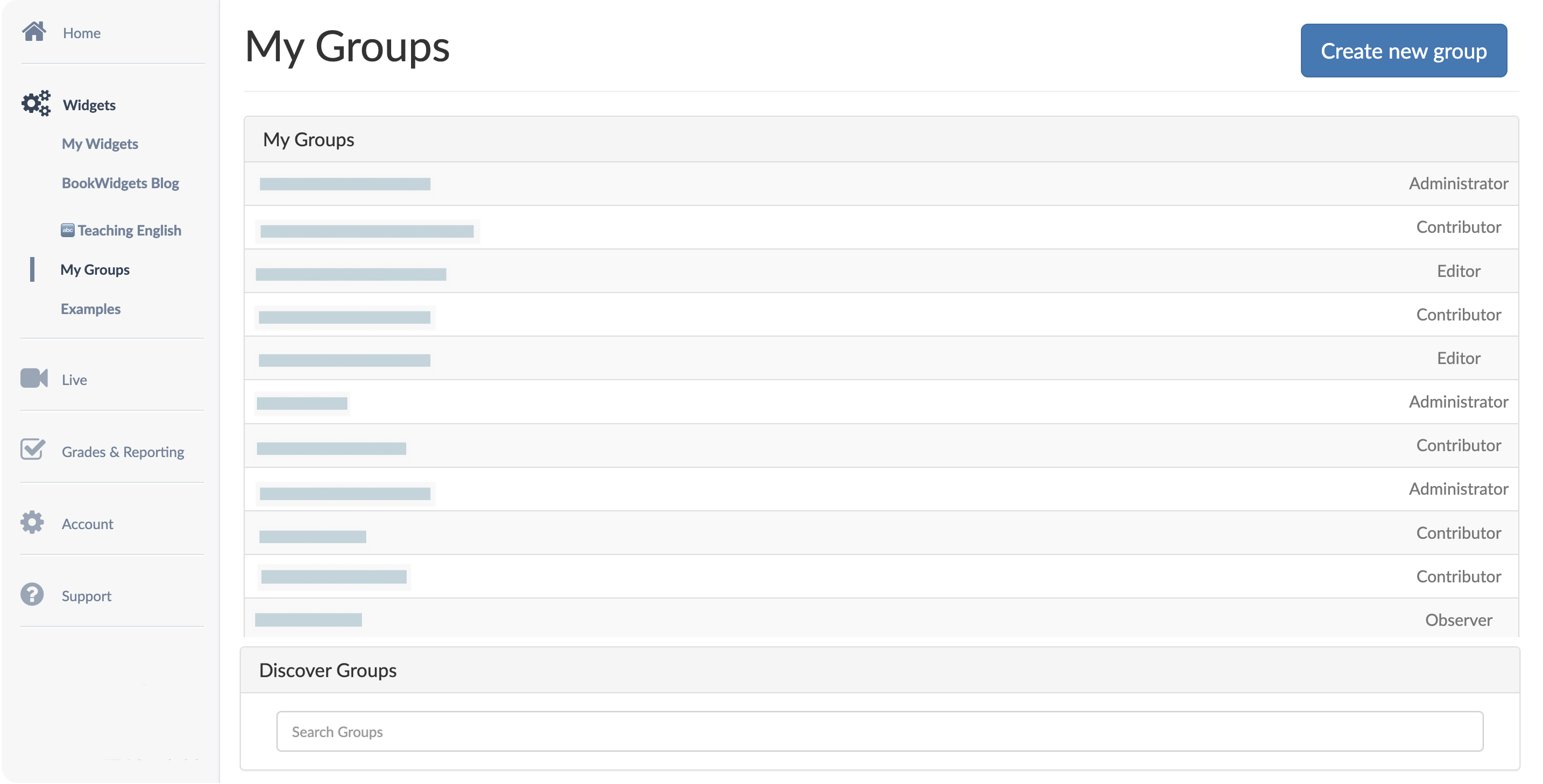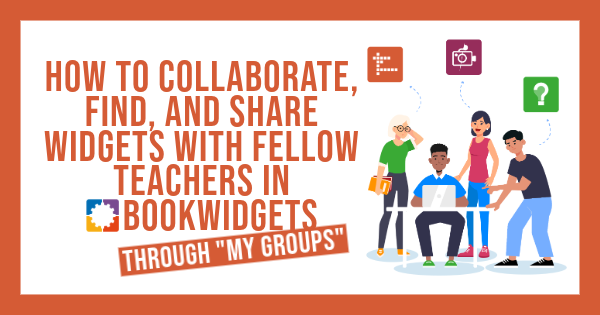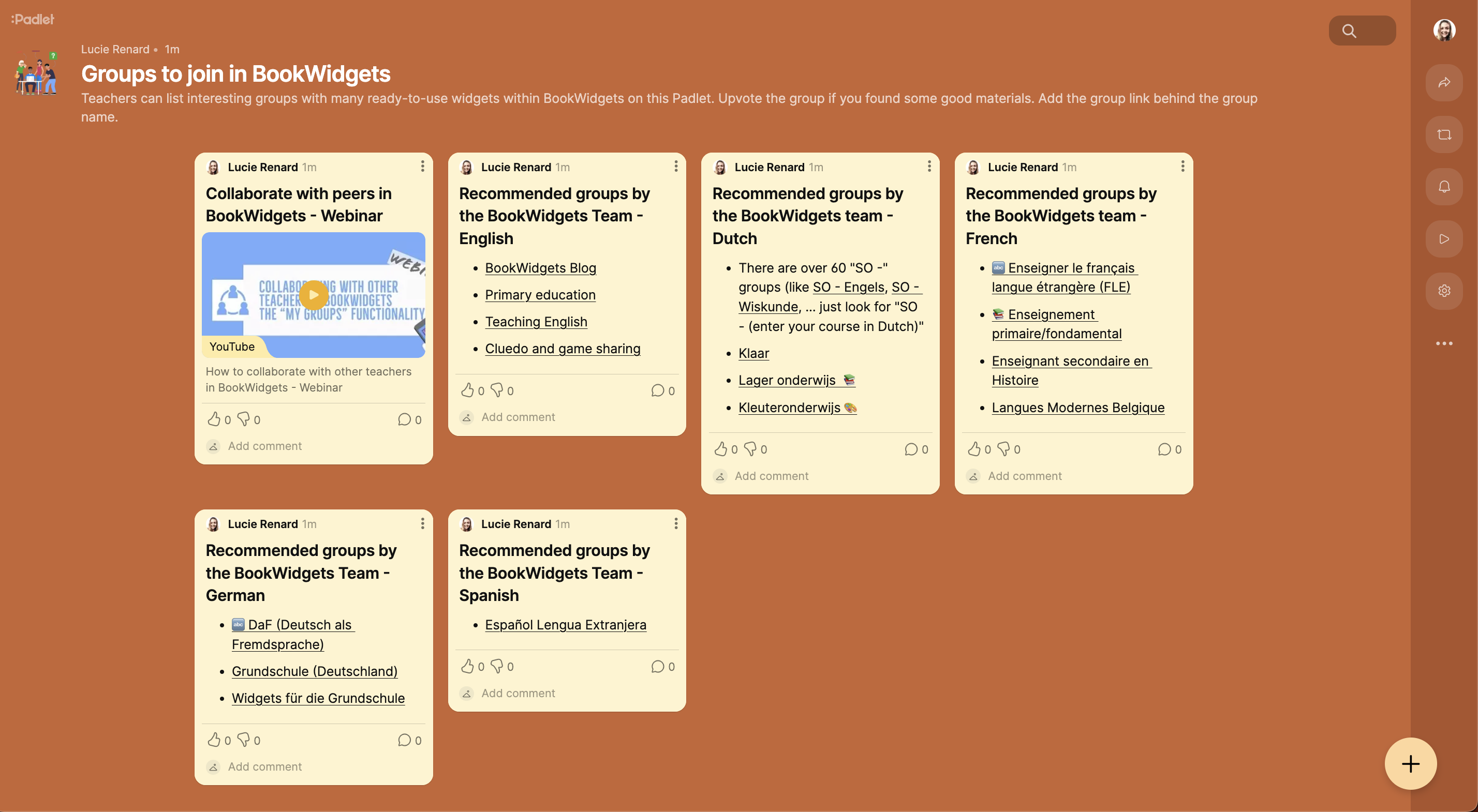How to Collaborate, Find, and Share Widgets with fellow teachers in BookWidgets through "My Groups"
 Lucie Renard —
Lucie Renard —
“Sharing is caring,” “Stronger together,” “The more you share, the more you have,”… This might sound cheesy, but it’s absolutely true! As a teacher, you have so much on your plate already. Collaborating on lesson plans and sharing interactive learning materials with fellow teachers will free up some time for your other responsibilities.
In this blog post, we dive into Bookwidgets groups, exploring things that make widget creation and collaboration a breeze. Say goodbye to only creating widgets from scratch, and hello to a new universe with ready-made content. Join me as we explore the power of organizing groups, understanding their types, and tapping into the collaborative potential of Bookwidgets. Discover how these groups can unlock creativity, enhance lessons, and make teaching enjoyable and efficient.
💡 Pro tip: We already did a webinar on this topic. So, if you would rather see a video, check out this recorded BookWidgets webinar on collaborating with peers in BookWidgets by using the “My group’s” functionality.
In this blog post:
- Where to find BookWidgets groups
- How to create a BookWidgets group
- Discover existing BookWidgets groups
- Use and share widgets with fellow teachers
- Keeping a group organized in Bookwidgets - Tips & Tricks
Before we move on 👇
Here’s a quick intro to BookWidgets. Since you’re here, you already understand what the BookWidgets teacher tool can do, but here it is again, just in case. BookWidgets is a content creation and evaluation tool for teachers. Teachers can:
- create digital assignments or activities - also called “widgets”;
- share those widgets with students through integration in various LMS like Google Classroom, Moodle, Canvas, Teams, and more;
- monitor student progress live while students are completing the widgets,
- review student work efficiently, provide personalized feedback, and return the work to students.

Where to find BookWidgets groups
Firstly, what is a group in Bookwidgets, and what does it do? A group is a place where you can share your widgets with your teacher colleagues or other BookWidgets users. This can be used by teachers who teach the same subjects to share ideas and help each other out or by the school you work in to gather all the widgets in one place. You can also create groups to collaborate with teachers worldwide, teaching the same course, the same grade, using the same books, and more.
Navigate to the “My Groups” page in BookWidgets. Here, you can create new groups and discover existing groups to find ready-to-use BookWidgets lesson materials.


How to create a BookWidgets group
Create a group yourself so you can share your widgets with other teachers and ask other teachers to also collaborate and share their widgets in your group. It can be a group on a higher school level, where all teachers of your school join that group and share widgets within their course folders.
- log into your BookWidgets account
- Go to Widgets > My groups
- Click Create new group
Now, there are a few actions to take.
1. Give your group a name and description
When you create a group, give it a name. This name is important later when teachers search for your group in the “Discover groups” field. In the description, write the group’s purpose. One example of its use is exchanging creative teaching concepts among teachers of French.
💡Pro tip: Don’t give your groups the same name as your connected courses in your learning management system. As connected courses will also show in BookWidgets, you won’t know the difference between a “course group” and a created group yourself when you give them the same name.
2. Choose a group privacy setting
Under the description, You will have the option to choose three types of groups: Public groups, Closed groups, and Secret groups. But what do they do, and what is the difference between them?
- Public groups are visible to everyone with a Bookwidgets account. By making your groups public, other BookWidgets users can find the group under “Discover groups” and can already see the widgets in the group, duplicate them somewhere else, and make changes to the duplicated widget. This is the best setting if you want to encourage all teachers to share widgets and you feel good about your widgets to share them with the BookWidgets community.
- Closed groups are more private. Here, your group will show in the “Discover groups” search, but teachers will have to Ask to join the group before they can see the widgets in the group. This is the ideal setting if you’re collaborating with a few colleagues, for instance, within the same school, and you want your colleagues to find the group easily but also make sure no other BookWidgets users will get in.
- Secret groups are, yes, you guessed it, secret. No one can see that this group exists. This group will not show in the “Discover groups” search. Only the administrator (creator of the group), can invite people to this group by entering the emailaddress they are using with BookWidgets.
3. Invite teachers to your group
When your group is ready, you can start inviting other teachers to your group. There are 3 ways to add teachers to your BookWidgets group:
- When your group is Public or Closed, teachers can find it through the “Discover groups” search box. When they click your group, they get a button in the upper right corner “Join this group”. When they click that button, the admin of the group will get an email with the question to accept that teacher to their group.
- You can invite teachers to your group by sharing the link to your group with teachers. Those teachers will also have to click the “Join this group” button.
- You can invite teachers to your group by clicking the cogwheel in your group configuration and entering the BookWidgets account email addresses of the teachers you want to add. This option is the only way to invite teachers to your group when it is set as “Secret” as there’s no way for other teachers to find it. The administrator needs to send out the invites. In this case, teachers will get an email, and when they navigate to “My groups,” they will see they have an open group invitation they can accept (or decline).
4. Assign different roles to your group members
When you accept teachers to become a member of your group, you (or other administrators) can assign a role to each member.
You can choose if those teachers are
- Observers can only view widgets and use them.
- Contributors can also add other widgets to the group to share with the group members.
- Editors can also edit all the widgets in that group, including their own shared widgets and widgets shared by other contributors.
- Administrators can do everything mentioned above and invite or accept members to that group.

Discovering groups in BookWidgets
We discovered earlier that there are a few types of groups. I want to talk a bit more about the public groups. There are quite a lot of helpful public groups in BookWidgets already. There are groups for many subjects with some widgets already in there. That way, you can interact with creative, enthusiastic teachers to enhance your teaching skills and have some cool widgets available. If you have any exciting widgets, feel free to share them with the people in these groups! To find these groups, go to “My Groups” and search for the subject you are interested in. We, as Bookwidgets, also have some fantastic groups we recommend. Here’s a list of some good groups:
- English groups: BookWidgets Blog, Primary education, Teaching English, Cluedo and game sharing
- Dutch groups: There are over 60 “SO -” groups (like SO - Engels, SO - Wiskunde, … just look for “SO - (enter your course in Dutch)”, Klaar, Lager onderwijs 📚, kleuteronderwijs
- French groups: 🔤 Enseigner le français langue étrangère (FLE), 📚 Enseignement primaire/fondamental, Enseignant secondaire en Histoire, Langues Modernes Belgique
- German groups: 🔤 DaF (Deutsch als Fremdsprache), Grundschule (Deutschland)
- Spanish groups: Español Lengua Extranjera
⚠️ As these groups are managed by BookWidgets users, some of the groups you will find are true hidden gems, but others can be messy. Needless to say, we have no control over groups created by the BookWidgets community. ⚠️ Remember! These groups only keep working when you also contribute widgets to them when you get a contributor role. It’s all about taking and giving, and Sharing is caring!
We created a Padlet board here so you can highlight more groups you want to invite other teachers to. Make sure to enter the language of the group as well and add a link to your group behind the group name. Other teachers can check these groups and ask to join. You can also upvote groups from other teachers in this Padlet board when you found some useful widgets in it.

Use and share widgets with fellow teachers
Now that you know how to access these groups, I will explain how to use the widgets you find there and share your own widgets in those groups as well.
How to use widgets from other teachers in a BookWidgets group
- Make sure to join the group when it’s closed. When it’s a public group, you don’t need to join, but we still encourage you to join so you may get a contributor role and share your widgets in that group. When you’re a member of a group, you’ll also see the group name appear on the left below “My Widgets.” This is a handy shortcut to access all the materials.
- Duplicate the widgets you want to use to the “My Widgets” folder or somewhere you can remember. Here’s how: select all the widgets you want to duplicate ➡️ click on the cogwheel icon ➡️ choose “Duplicate selected widgets” ➡️ navigate to the correct group in the pop-up-screen ➡️ choose “Duplicate”. Now, you can visit this group, edit your duplicated widgets (if necessary), and share them with your students.
How to share your widgets with other teachers in a BookWidgets group
- Make sure to join the group when it’s closed. When it’s a public group, you also need to be a member. The administrator needs to give you a contributor role so you can share your widgets in these groups. When you’re a member of a group, you’ll also see the group name appear on the left below “My Widgets.” This is a handy shortcut to access all the materials.
- Go to “My widgets”, or another group with materials of your own making ➡️ Select the widgets you want to share ➡️ click on the cogwheel icon ➡️ choose “Duplicate selected widgets” ➡️ using the pop-up dialogue, navigate to the group you want to share the widgets in ➡️ Navigate to a suitable folder (or immediately create one) ➡️ choose “Duplicate”.
💡Pro tip: When you duplicate your widgets, nothing can go wrong as the original widgets stay with you, where you will always be able to find them.

Keeping a BookWidgets group organized - Tips & Tricks
Here are some extra tips for keeping your BookWidgets groups organized. A lot of the tips below are implemented in this example group we created. Make sure to check the group and hopefully, you can take away some useful tips.
💡 Already create a folder structure
It’s better to use a simple structure to track which widget is stored in which folder. As an administrator, make sure to already add folders with names to your group that will serve as the group structure. You can use emojis to represent those folders or assign them numbers.
💡 Create an instructions widget
So teachers know the rules of your group and can help keep it organized. Create a quiz widget and disable “submitting of answers” and “correction and scoring options”. This way, you just have an “interactive page” instead of a quiz. You can also create a PDF with instructions and share it within a PDF widget. Share this information in your instructions widget:
- Structure tips: Where should they best place their widgets? Which folders? Information on folder structure? Where to place widgets that don’t fit into a folder? …
- Guidelines for editors/administrators: May they delete widgets? How do they clean up widgets/ keep the group organized? Rest folder? Trash folder? …
- Rules for widget titles and descriptions: Working with emojis? Which emojis and what do they represent? Abbreviations? End-term numbers? Curriculum goal numbers?
- Design rules: Link to a (Google) drive with design templates for widgets, Link to a folder with widgets that can serve as templates, and add a widget with a text question with a school header to import this question into other widgets, …
- Rules on credits and info in widgets: Where do you place credits? What additional information and clarification do you provide in a widget (about tab)? Provide an example text/template that teachers can use and fill in themselves.
💡 Recover deleted widgets
Good news for teachers who delete widgets they weren’t supposed to delete in your group: You can recover deleted widgets in your group by clicking the cogwheel icon, choosing “Go to deleted widgets,” and clicking the “Restore” button behind the widgets you want to recover.
💡 Use the search filter to look for widgets
This is a tip for all group members. To find your widgets quick and easy you can use the search filter on top of your BookWidgets group. Search for
- Widget title (or words in a widget title)
- Widget description (= only visible for teachers, not students). Adding a description to your widgets is very important to ensure that others (and yourself) can find them more easily. Use emojis, abbreviations, curriculum goal numbers, etc.
- Widget type (= Quiz, Worksheet, Crossword, Pair Matching…)
- Short code (or first letters of that short code)
- Widget owner (= Person who created the widget)
Wrap up
That’s it! I hope this information on collaborating with fellow teachers in BookWidgets has got you eager to start discovering groups and sharing widgets with other teachers.
Want to learn more about creating engaging lesson activities with BookWidgets? ✔️ Follow BookWidgets on X / Twitter, LinkedIn, Instagram, and join our teacher community on Facebook! ✔️ And, be sure to connect with me, Lucie, on LinkedIn! 👋



